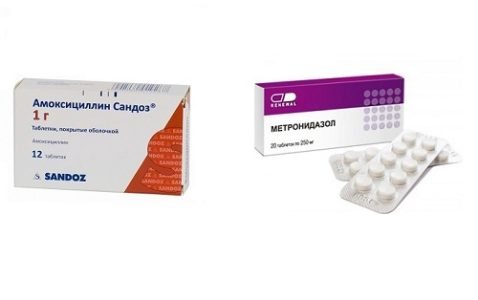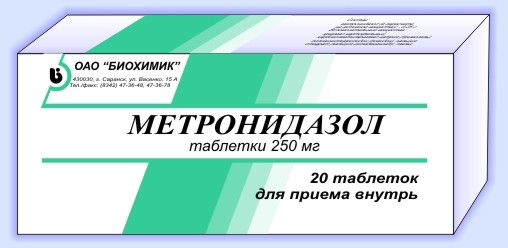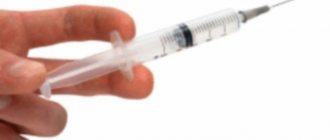Stomach ulcer is a disease that requires complex treatment. It is aimed, first of all, at destroying the culprit of Helicobacter pylori infection, although it does not always provoke the disease, because it is powerless against a strong immune system, a stable nervous system, a balanced diet and the absence of bad habits.
Proper treatment of stomach ulcers is impossible without:
- quitting smoking and alcohol abuse;
- correction of the mental sphere;
- diet therapy;
- treatment using drugs from different pharmacological groups;
- if surgical intervention is necessary.

Drug treatment
Conservative treatment is carried out using:
- Proton pump inhibitors (PPIs) are drugs that block the proton pump, which interferes with the secretion of chloride acid. The PPI group includes: Omez, Nolpaza, Omeprazole.
- Histamine receptor blockers (HRBs), which reduce the production of chloride acid. This category includes: Roxatidine, Quatemal and others.
- Antibacterial drugs. One of the most effective antibiotics used for stomach ulcers is Metronidazole. It has a wide spectrum of action. Interrupts oxidative processes in bacterial cells, thereby inhibiting their vital activity. With prolonged use, it destroys the hereditary material of pathogenic microflora, which prevents the disease from becoming chronic, as well as the development of relapses. The drug quickly reaches the site of ulceration and there it exerts its therapeutic effect. Prescribed in combination with Amoxicillin.
The following groups of medications are also indicated for patients with stomach ulcers:
- Antacids (Maalox, Phosphalugel), which have an adsorbing effect and neutralize the aggressive environment of gastric juice. They relieve burning and pain, thereby helping with heartburn.
- Ganglioblockers. They inhibit nerve impulses aimed at the secretion of gastric juice and contraction of muscle fibers in the walls of the stomach.
- Prokinetics. They stimulate complete digestion, normalize metabolic processes, improve peristaltic contractions of the walls of the digestive canal, and also relieve heaviness in the stomach, constipation, and prevent vomiting and heartburn. Examples of drugs: Trimedat, Motilium, etc.
- Bismuth-containing drugs. They reduce the activity of bacteria, coat damaged areas of the mucosa, and relieve symptoms of the disease (Pilocid, Ventrisol, De-Nol).
- Drugs that have an antisecretory effect reduce the secretion of gastric juice and its pH. PPIs, BGCs and anticholinergics have these properties. Drugs from this group: Gastrocepin, Ranitidine, Nexium.

Taking the drug "Trichopol", dosage features for gastritis
Recently, a huge variety of medicines have been found that help effectively relieve pain due to gastritis. A medicine such as Trichopolum is prescribed quite rarely for gastritis.
As a rule, its use is resorted to only when the disease is caused by the bacterium Helicobacter pylori.
Trichopolum" is a synthetic antibacterial drug; as practice shows, it should be taken together with other drugs.
Only complex therapy helps to achieve effective lasting results. True, the use of Trichopolum should be abandoned during eradication.
It will be better if the product is used together with tablets that help reduce stomach acidity.
If other causes are identified that affect the inflammation of the gastric mucosa, gastritis, as a rule, is treated not with Trichopolum, but with other medications that have an atypical composition.
Composition of the drug
The predominant component of Trichopolum is metronidazole. It was this active substance that was chosen by the Maastricht Treaty, becoming one of the most effective antibiotics with which Helicobacter pylori can be eradicated.
True, Russians, who resort to self-medication more often than citizens of other countries, use metronidazole for the wrong purposes when it is needed.
It was this fact that influenced the fact that the body’s resistance to the remedy of a resident of Russia is several times higher than that of a person living in Europe.
In fact, it is this fact that increasingly determines the doctor’s refusal to prescribe Trichopolum for gastritis; if the patient presents with the corresponding symptoms, he is usually prescribed other medications.
The methods of therapeutic effects on the human body developed by Russian doctors usually come down to the use of Nifuratel. "Trichopol" can be prescribed to a patient only if treatment according to the first line developed does not bring the desired result.
In addition, Trichopolum is used if it is necessary to adjust the method of treatment or replace it.
Those who are interested in how to take Trichopolum for gastritis should not only read the instructions, but also visit their doctor. Usually this medicine is taken three times a day, 500 mg. As a rule, the course of treatment lasts for two weeks.
Dosage form
A drug such as Trichopolum may have several dosage forms. As a rule, you can purchase oral tablets that contain 250 mg.
active substance or tablets for vaginal use, their composition contains metronidazole up to 500 mg. If necessary, on the recommendation of a doctor, you can use a solution for infusion; it is sold in ampoules of 20 ml.
Each of them contains 100 mg. active remedy.
As a rule, Trichopolum is able to cure infections such as trichomoniasis, giardiasis, and amebiasis. At the same time, this drug helps get rid of liver abscess, peritonitis, endometritis, pneumonia, sepsis, and endocarditis.
Who should stop using Trichopolum?
If a patient decides to take Trichopolum for the treatment of gastritis, he should first familiarize himself with a number of existing contraindications.
As a rule, anyone who suffers from pathologies such as blood disease, poor coordination, or liver failure should avoid using the drug.
Naturally, anyone who has diseases of the nervous system and is sensitive to metronidazole should not take the medicine.
If a pregnant woman consults a doctor and needs to take Trichopolum in order to reduce the manifestations of gastritis, the drug must be used with extreme caution. It is extremely important to avoid its use during the first trimester.
Subsequently, the doctor needs to compare the percentage of benefits and risks for the unborn child. Studies show that metronidazole is able to be absorbed into the placenta.
When the drug is consumed by the mother of the baby, metronidazole passes to the baby through mother's milk, producing a bitter taste. During lactation it is better to avoid taking this medication.
In the event that treatment is carried out exclusively with tablets, breastfeeding will have to be abandoned, giving the child breast milk only two days after the full course of treatment has been completed.
Conclusion
"Trichopol" is used for gastritis quite rarely, which is due to the resistance of the Russian body to metronidazole.
Just like other medications, the drug has a number of specific contraindications and side effects. In any case, you must visit a doctor before using the drug.
Today, Trichopolum produces, which is located in Poland.
Source: https://PobediGastrit.ru/lekarstva/kak-prinimat-trihopol-pri-gastrite.html
Two-stage treatment regimen
The treatment regimen for stomach ulcers is selected by the doctor individually.
Most often it consists of two stages:
- In the first, which lasts a week, treatment is carried out with two antibiotics, usually this complex of clarithromycin and metronidazole. Lansoprazole, which belongs to the PPI group, may also be prescribed. The dosage is determined by the doctor based on the individual characteristics of each patient.
All this is done to solve the main task of the first stage - the elimination of Helicobacter pylori. It is almost impossible to achieve complete destruction of Helicobacter (there are several types). Dying in the stomach, the pathogenic microbe descends lower into the intestines, causing inflammation. Re-infection through shared utensils and during fibrogastroduodenoscopy (FGDS) is also possible.
- The duration of the second stage is two weeks, during which the destruction of Helicobacter continues. For this, a complex of tetracycline and metronidazole is used. For auxiliary therapy, bismuth-containing drugs are used, Famotidine and Ranitidine from the BHR group, Rabeprazole, Omeprazole from the PPI group.
Auxiliary therapy is carried out using various groups of medications to relieve unpleasant symptoms of the disease and speed up the recovery process.

How to take Amoxicillin and Metronidazole at the same time
The drugs are taken orally according to the treatment regimen prescribed by the doctor. The recommended dosage is 750 mg of amoxicillin and 500 mg of metronidazole (1 tablet) 3 times a day. If you have kidney disease, the frequency of taking tablets is reduced to 2 times a day.
The duration of treatment is 12 days, in individual cases it can be extended to six months. Amoxicillin is taken before meals, and Metronidazole is taken after meals. The tablets must be taken with a sufficient amount of water.
Antibiotics are not prescribed to patients with diseases of the central nervous system, pathologies of the circulatory system, pregnant and lactating women, and minors. During treatment, it is recommended to avoid activities that require increased concentration and rapid psychomotor reactions.
Three-component treatment regimen
If a stomach ulcer develops against a background of high acidity, antibiotics, antacids and PPIs are used as components of a three-step treatment regimen:
- Antibacterial compounds such as Tetracycline and Amoxicillin are used as the first component.
- The second component is Tinidazole.
- And third: medications containing bismuth and compounds from the PPI group.
For auxiliary therapy, probiotics, prokinetics, antispasmodics, antidepressants, as well as sedatives that normalize the emotional sphere are prescribed.
Amoxicillin and Metronidazole - how to take for gastritis?
Gastritis associated with H. Pylori infection should be treated with aggressive antibiotic therapy. Otherwise, there is a high risk of developing an ulcer. Many years of experience in using quadruple therapy allowed us to select the optimal doses of drugs. According to reviews from both gastroenterologists and the patients themselves, the greatest positive effect can be achieved with the following 7-day course of treatment:
- Omeprazole 20 mg 2 times a day;
- Clarithromycin 0.5 g 2 times a day;
- Amoxicillin 1 g 2 times a day;
- Metronidazole 0.5 g 2 times a day.
It is necessary to understand that the use of Metronidazole with Amoxicillin alone will not lead to any positive effect - Clarithromycin and Omeprazole must be used in combination with them. An additional antibacterial drug is necessary to ensure the destruction of bacteria. Omeprazole eliminates the effect of hydrochloric acid on the stomach wall damaged by Helicobacter. At the same time, there are many variations of both quadruple therapy itself (with bismuth preparations, tetracycline, etc.) and a variety of schemes for eliminating Helicobacter as such. If this treatment regimen is ineffective or impossible, it is necessary to select another combination of drugs.
Physiotherapy
In parallel with conservative treatment, the patient receives physiotherapy:
- Ultrasound therapy, which has an antisecretory effect.
- Electrophoresis using anesthetic compounds.
- Electrical therapy eliminates constipation, normalizes digestion, improves the healing of ulcerations, and also has an anti-inflammatory and analgesic effect. For constipation, your doctor may prescribe: enemas, suppositories, and laxatives.
- The use of heat in the form of a warming alcohol compress to improve local blood circulation and pain relief.
Diet therapy
Food for patients with stomach ulcers should not injure the mucous membrane and supply all the nutrients the body needs. It is recommended to take 5 small portions of food. Dishes must be liquid, warm, boiled or steamed. It is better to give preference to pureed porridges, slimy soups, compotes and jelly.
Products that need to be excluded from the diet:
- spicy, salty, fried foods;
- smoked meats;
- alcohol, coffee, tea;
- spices;
- bread;
- citrus fruits, tomatoes, cabbage, etc.

Metronidazole for the stomach
Metronidazole is used as part of complex treatment for gastritis.
This pharmaceutical drug has a wide spectrum of action, which also applies to pathologies of the digestive system.
"Metronidazole" with a pronounced antibacterial effect helps relieve inflammation from the affected gastric mucosa and cleanse it of pathogenic microorganisms that destroy the walls of the digestive organ.
Release form, composition and mechanism of operation
The drug is sold in the form of a powder from which a liquid for intravenous administration is prepared, a solution for infusion, a suspension, tablets for oral administration, and also in the form of vaginal pills.
The main component of the drug is metronidazole, which has a pronounced antibacterial, antiprotozoal and antimicrobial effect. Metronidazole has a detrimental effect on pathogenic microorganisms, disrupting their respiratory processes and causing cell death.
When taken orally, the drug substances are quickly and completely absorbed from the gastrointestinal tract, reaching its maximum concentration after 1-3 hours.
Indications
It is important to take the drug "Metronidazole" as an adjuvant in the treatment of pathological conditions such as:
- inflammation of the inner lining of the heart;
- infectious damage to the abdominal organs and lungs caused by aerobic bacteria;
- infectious inflammation of all components of bone tissue;
- urethritis and vaginitis;
- giardiasis;
- chronic tonsillitis;
- peritonitis;
- abscesses of soft and bone tissue structures.
The drug copes with helicobacteriosis, which provokes stomach ulcers.
Metronidazole is often prescribed to prevent the development of complications after surgery. In addition, the medication is used to treat gastritis, and in combination with other medications, it is used to treat gastric ulcers caused by the active activity of the Helicobacter pylori bacterium.
How to use?
Before using Metronidazole as part of a complex treatment of stomach diseases, it is important to consult a specialized physician who will prescribe a therapeutic course individually for each patient.
For adults and children over 16 years of age, the dosage is 1-2 tablets per day, which should be taken after a meal with a large volume of water. You are allowed to consume no more than 6 pieces per day.
The duration of the treatment course is 7-10 days, depending on the severity of the inflammatory process occurring on the walls of the organ. You need to drink Metronidazole for stomach ulcers in combination with an antibiotic such as Amoxicillin in a dosage of 2 tablets.
three times a day. The duration of treatment usually takes up to 14 days.
Contraindications and adverse reactions
If there are few leukocytes in the patient’s blood, then the drug is contraindicated.
Not everyone is allowed to use Metronidazole for the treatment of stomach diseases. The medicine should not be used by patients with hypersensitivity to its components, pregnant or nursing mothers.
The drug is contraindicated in patients who have been diagnosed with severe pathologies of the central nervous system, as well as those who have been diagnosed with acute liver or kidney failure.
In addition, a contraindication to the use of Metronidazole is a pathological condition, which is characterized by a reduced number of leukocytes in the blood.
In most cases, the drug is well tolerated, but if it is abused, side symptoms will not take long to appear. And then the patient may face such undesirable consequences as:
- flatulence, frequent loose stools;
- severe itching of the skin, urticaria;
- increased body temperature;
- pain in the temples and back of the head, dizziness;
- urinary disturbance;
- dry mouth.
Compatibility
It should be able to enhance the effect of indirect anticoagulants, and this is fraught with an increase in the time of prothrombin formation, therefore, with such a tandem, there is a need to adjust the dose of the anticoagulant.
In addition, when using an antimicrobial drug simultaneously with Disulfiram, the risk of developing various neurological symptoms increases.
Therefore, it is important to maintain an interval between doses of these medications, and it is better if it is more than 2 weeks.
The drug cannot be combined with alcoholic drinks.
There is an increase in the antimicrobial effect of Metronidazole when it interacts with sulfonamides. While undergoing treatment with the antibacterial drug in question, you should not drink alcohol, as this is dangerous due to the occurrence of abdominal pain, nausea, severe headaches and skin flushing.
Similar means
The following analogue drugs can replace Metronidazole:
- "Trichobrol";
- "Metrogil";
- "Siptrogil";
- "Bacimex";
- "Efloran";
- "Klion";
- "Metrovagin";
- "Rozamet";
- "Metron";
- "Metrolacare";
- "Trichosept";
- "Deflamon".
Conditions of release and storage
The antibacterial drug is dispensed from pharmacies only with a doctor's prescription. Metronidazole should be stored in a place protected from moisture and direct light at a room temperature of no higher than 26 degrees Celsius. Small children should not have access to the medicine. Shelf life: 5 years. Do not use the drug after the date indicated on the package.
Source: https://EtoZheludok.ru/lekarstva/metronidazol-i-zheludok.html
Surgery
In severe cases, the only option is surgery.
We are talking about conditions when:
- the ulcer has degenerated into a cancerous tumor;
- there is internal bleeding;
- drug treatment was ineffective;
- the stomach was deformed, scars appeared on its walls;
- the disease is accompanied by the last stage of stenosis.
Treatment of the acute form is carried out in a hospital setting, because the use of antibiotics may be accompanied by side effects. In addition, the pathology itself is quite individual: patients have different pH levels of gastric juice, and complications affecting other organs are possible. All this requires constant monitoring by a qualified gastroenterologist to ensure successful treatment results.

Medicines for gastritis and stomach ulcers
Have you been struggling with GASTRITIS and ULCERS for many years without success?
Head of the Institute: “You will be amazed at how easy it is to cure gastritis and ulcers simply by taking it every day...
4. To cure gastritis with high acidity, carry out:
- Anti-inflammatory therapy. Use products with an enveloping and astringent effect.
- The production of gastric juice is corrected by taking tablets such as Alumag, Famotidine, Rennie and other H2 blockers.
- Along with this, regenerative medicines are used - Karanitin and Kaleflon.
- In order for the therapy to have a general targeted effect, antispasmodics such as Metoclopramide and Eglony are used in treatment.

5. For gastritis with low acidity, the following is prescribed:
- Correcting impaired gastric secretion using replacement therapy with Acedin-Pepsin and other tablets to stimulate the production of gastric juice.
- Dalargin helps restore the mucous membrane.
- The use of Metoclopramide can restore normal motor skills.
- If gastritis is accompanied by digestive disorders, doctors advise taking Panzinorm, Festal or Pancreatin.
All of the above medications can only be prescribed by doctors after a complete examination of the patient. Based on the results of laboratory tests, the gastroenterologist makes a diagnosis, and only then does the choice of therapy occur.
Additional drugs
Many patients, in addition to the medications prescribed by the doctor, use traditional medicine. Herbal infusions are mainly aimed at maintaining immunity. It is these actions that help quickly treat the disease. By the way, herbal tablets for gastritis and ulcers are well tolerated and have no side effects.
List of herbal medicines:
1. Iberogast, based on milk thistle, chamomile, angelica, caraway and other herbs, has an anti-inflammatory effect and relieves symptoms in a short time. Reception is relevant when prescribing antibiotics. The product also improves digestive processes, eliminates cramps and heartburn.
2. Herbal tea "Ekolulko" is taken for gastritis with low acidity and to neutralize bloating in the stomach. The intake and dose are indicated in the instructions for the drug.
3. “Ulkus Sept” drops based on propolis and herbs help with digestive problems, ulcers, and high production of gastric juice. Take 20 drops 2-3 times a day.
Prevention
Effective treatment is only possible if an integrated approach is followed. An important point is changing your lifestyle and diet:
- rejection of bad habits;
- gymnastics;
- balanced diet;
- avoid eating GMO products, spicy and fried foods;
- drink more still water.
You can get more detailed information about preventive methods by visiting the office of a gastroenterologist and nutritionist. After diagnosing, doctors prescribe a list of remedies and additional procedures. Joint actions will help get rid of the disease and avoid its recurrence.
Folk remedies against stomach ulcers
After consultation with your doctor, you can also use traditional medicine, in particular, infusions and decoctions, for the preparation of which the following were used:
- aspen buds;
- apple and strawberry leaves;
- yarrow, marsh grass and fireweed.
To relieve heartburn, it is recommended to take:
- carrot juice;
- baking soda solution;
- milk;
- calamus root (decoction);
- pea powder;
- nuts.
Neutralizes the acidic environment of gastric juice and potato juice. They drink it throughout the week, 0.5 cups 1 hour before breakfast.
Treatment methods for gastric ulcers continue to improve. A high healing effect can be achieved with the help of growth factors, trefoil peptides and cytokine preparations. A vaccine against Helicobacter pylori is also at the testing stage.
Metronidazole is used as part of complex treatment for gastritis. This pharmaceutical drug has a wide spectrum of action, which also applies to pathologies of the digestive system. "Metronidazole" with a pronounced antibacterial effect helps relieve inflammation from the affected gastric mucosa and cleanse it of pathogenic microorganisms that destroy the walls of the digestive organ.

Amoxicillin: a brief description
Metronidazole is a complex drug with antimicrobial and antibacterial properties.
The simultaneous use of alcohol and Metronidazole causes a condition reminiscent of alcohol poisoning - migraine, nausea, lack of appetite, dizziness, loss of orientation. Therefore, it is recommended to avoid alcohol during the period of treatment with Metronidazole.
The drug has a high level of absorption. After oral administration of the tablet, the active substance quickly penetrates the liver, kidneys and lungs. Traces of Metronidazole are visible in saliva, gastric secretions and vaginal secretions. Due to the ability of the drug to appear in breast milk during lactation, Metronidazole therapy is contraindicated.
Topical use of the product is indicated for the healing of ulcerative lesions, poorly healing wounds and the elimination of acne.
Features of therapy
Features of treatment are determined by the release form of Metronidazole.
- Tablet form - oral administration of 250 milligrams of metronidazole twice a day. The duration of treatment is prescribed by the attending doctor depending on the severity of the disease and the individual characteristics of the patient;
- Vaginal suppositories – 1 suppository once before bedtime for 7-10 days;
- Intravenous injections are prescribed for the development of complications or the addition of a secondary infection. Dosage – 500 milligrams every 6-8 hours. Injection therapy with Metronidazole is indicated in the postoperative period for the prevention of bacterial infections.
Adverse reactions during treatment with Metronidazole are rare.
- Dyspeptic disorders - nausea, vomiting, stool disorders, lack of appetite, glossitis, hepatitis and stomatitis;
- CNS (central nervous system) disorders - increased drowsiness, severe migraines, insomnia, lack of coordination, depression, tremors or convulsions;
- Skin manifestations - redness, itching, burning, rashes;
- Genitourinary system - change in urine color, inflammation of the kidneys, burning sensation in the ureter.
Due to its high toxicity, it is not recommended to prescribe Metronidazole for pathologies of the central nervous system, hematopoietic disorders or impaired liver function. It is prohibited to use the medication during pregnancy, breastfeeding, gastrointestinal disorders, and pathologies of the cardiovascular system.
During Metronidazole therapy, the doctor must monitor the patient’s blood counts, especially if there is a history of kidney or liver dysfunction.
Tinidazole is produced in tablet form. In addition to the active substance, the medicine contains dioxide, titanium, magnesium stearate, and starch.
When taken orally, Tinidazole is easily absorbed into the stomach and penetrates into the liver, kidneys and breast milk. The main indications for prescribing the drug are giardiasis, candidiasis, trichomoniasis, anaerobic lesions and the prevention of secondary infections in the postoperative period.
- Bacterial infections, trichomoniasis, candidiasis, giardiasis – 4 tablets daily for 3-7 days;
- Aerobic infections in children – 2 capsules per day for 5-6 days.
Metronidazole is an antibiotic with a broad spectrum of antimicrobial, antibacterial and antiprotozoal action. The drug is actively used in the treatment of parasitic and infectious diseases.
Release form, composition and mechanism of operation
The drug is sold in the form of a powder from which a liquid for intravenous administration is prepared, a solution for infusion, a suspension, tablets for oral administration, and also in the form of vaginal pills. The main component of the drug is metronidazole, which has a pronounced antibacterial, antiprotozoal and antimicrobial effect. Metronidazole has a detrimental effect on pathogenic microorganisms, disrupting their respiratory processes and causing cell death. When taken orally, the drug substances are quickly and completely absorbed from the gastrointestinal tract, reaching its maximum concentration after 1-3 hours.
How to treat
Before prescribing treatment, it is necessary to determine the type of gastritis: acute or chronic. If the disease occurs as a result of poisoning, it is necessary to begin therapy with gastric lavage. The patient is recommended to diet and take antispasmodics. Gastritis can be purulent, chemical, catarrhal, bacterial. Special methods of therapy are used for each. The only thing that remains is to follow a gentle diet.

For the treatment of chronic erosive gastritis, Trichopolum is one of the few drugs that effectively and quickly cope with the disease. It not only eliminates the symptoms, but also fights the cause, that is, it destroys bacteria and harmful microorganisms. Therapy for the chronic form includes taking medications, eliminating the cause of the disease, following a diet, and spa treatment. Treatment of gastritis with folk remedies is also possible. Medications are prescribed by the doctor taking into account the acidity of the stomach. If it is elevated, it is advisable to take adsorbent, enveloping, antacid agents. If the acidity level is low, drugs are recommended that enhance the secretory function of the stomach.
Indications
It is important to take the drug "Metronidazole" as an adjuvant in the treatment of pathological conditions such as:
- inflammation of the inner lining of the heart;
- infectious damage to the abdominal organs and lungs caused by aerobic bacteria;
- infectious inflammation of all components of bone tissue;
- urethritis and vaginitis;
- giardiasis;
- chronic tonsillitis;
- peritonitis;
- abscesses of soft and bone tissue structures.
The drug copes with helicobacteriosis, which provokes stomach ulcers.
Metronidazole is often prescribed to prevent the development of complications after surgery. In addition, the medication is used to treat gastritis, and in combination with other medications, it is used to treat gastric ulcers caused by the active activity of the Helicobacter pylori bacterium.
Treatment of gastritis with Trichopolum
Published: July 3, 2020 at 12:36 pm
Today Trichopolum is used extremely rarely for gastritis; the drug is prescribed only when the cause of the disease is the bacterium Helicobacter pylori. This synthetic antibacterial agent is part of complex therapy; it is not used outside of eradication; its use is only appropriate in combination with tablets that reduce stomach acidity. If other causes of inflammation of the gastric mucosa are identified, treatment of gastritis with Trichopolum is not carried out.
The active substance of the described drug is metronidazole. It is recommended by the Maastricht Treaty as one of the antibiotics for the eradication of Helicobacter pylori. But in Russia, due to the popularity of self-medication, Metronidazole is often used very widely and for other purposes, so resistance to the drug is twice as high as in Europe.
This fact explains why Trichopolum for gastritis in our country is prescribed to patients less and less often. Russian doctors, when drawing up therapeutic regimens, give their preference to another drug - Nifuratel. Treatment of gastritis with Trichopolum is carried out only when the first line does not work and there is a need to correct it by making a replacement.
This drug is taken for gastritis three times a day, 500 mg. The course lasts two weeks.
When should you not take Trichopolum?
There are contraindications; Trichopolum is not prescribed for gastritis in the following cases:
- If you have blood diseases.
- If there is a violation of movement coordination.
- In case of liver failure and the existence of diseases of the central nervous system.
- With hypersensitivity to Metronidazole.
During pregnancy, treatment of gastritis with Trichopolum is carried out extremely carefully. Its use in the first trimester is prohibited. In the second and third trimester it is allowed only if the benefit to the woman outweighs the risk to the unborn child. Metronidazole easily penetrates the placenta. It is also secreted into mother's milk, giving it a bitter taste. Therefore, it is necessary to stop taking this drug during feeding. If therapy still takes place with the use of tablets, breastfeeding should be stopped. You can return to feeding only two days after the end of treatment. Trichopolum is produced by Polpharma Poland.
zhkt.guru
How to use?
Before using Metronidazole as part of a complex treatment of stomach diseases, it is important to consult a specialized physician who will prescribe a therapeutic course individually for each patient.
For adults and children over 16 years of age, the dosage is 1-2 tablets per day, which should be taken after a meal with a large volume of water. You are allowed to consume no more than 6 pieces per day. The duration of the treatment course is 7-10 days, depending on the severity of the inflammatory process occurring on the walls of the organ. You need to drink Metronidazole for stomach ulcers in combination with an antibiotic such as Amoxicillin in a dosage of 2 tablets. three times a day. The duration of treatment usually takes up to 14 days.
Metronidazole for gastritis instructions
Metronidazole is the first active substance that was once used to destroy the pathogenic bacteria helicobacter pylori for gastritis, gastroduodenitis and gastric ulcers.
The tablets are white, with a yellowish-greenish tint, flat-cylindrical; there is a transverse stripe. In addition to the key component, the composition includes povidone, stearic acid and potato starch. The components of the drug disrupt protein synthesis in the cells of pathogenic microorganisms and interfere with tissue respiration of bacteria.
The active substances are involved in metabolic processes and are metabolized in the liver, and then very slowly removed from the body. Excretion is carried out mainly in urine (up to 80%) and to a lesser extent in feces. The drug is usually taken after or during meals. The tablet is not chewed. Dose for adults: 2 tablets three times a day.
The course of anti-Helicobacter therapy usually lasts 7 days. Often it is combined - that is, at the same time the patient is asked to take other pills (for example, amoxicillin, amosin).
Analogs of metronidazole trichopolum; ornidazole; secnidazole; Tinidazole Their auxiliary components differ, which is important when prescribing medicine to patients with a tendency to one or another allergic reaction.
Contraindications and adverse reactions
Not everyone is allowed to use Metronidazole for the treatment of stomach diseases. The medicine should not be used by patients with hypersensitivity to its components, pregnant or nursing mothers. The drug is contraindicated in patients who have been diagnosed with severe pathologies of the central nervous system, as well as those who have been diagnosed with acute liver or kidney failure. In addition, a contraindication to the use of Metronidazole is a pathological condition, which is characterized by a reduced number of leukocytes in the blood.
In most cases, the drug is well tolerated, but if it is abused, side symptoms will not take long to appear. And then the patient may face such undesirable consequences as:
- flatulence, frequent loose stools;
- severe itching of the skin, urticaria;
- increased body temperature;
- pain in the temples and back of the head, dizziness;
- urinary disturbance;
- dry mouth.
Return to contents
How to take Metronidazole for gastritis
Most often, the drug is prescribed to patients in the form of tablets. They are white with a slight green tint. Before prescribing Metronidazole, the doctor must find out how the person eats and what additional medications he takes.
For erosive gastritis, Metronidazole should be taken three times a day during or after meals. The maximum daily dose is 6 tablets. You can't chew them. They are swallowed whole and washed down with water (large quantities). The maximum duration of the therapeutic course is 7 days.
Helicobacter is an insidious bacterium, as it quickly loses sensitivity to antibiotics. Therefore, even a mild form of gastritis is difficult to treat. To cope with the disease, Metronidazole is used in conjunction with other drugs: Amoxicillin.
To cope with the disease, Metronidazole is used in conjunction with other drugs Amoxicillin
This scheme is used only if the test for the presence of pathogenic microflora in the stomach is positive. The dosage of the drug is calculated by the doctor. The standard treatment regimen for gastritis with Metronidazole involves taking the drug twice a day, 500 mg.
After taking the pill, you should not drive a car for the next few hours, as side effects such as dizziness, clouding of consciousness, and slowed psychomotor functions are possible. If the functionality of the liver and kidneys is impaired, the treatment of gastritis requires adjustment of the dosage of Metronidazole.
If it is necessary to use the drug with indirect anticoagulants, you must carefully review the contraindications and establish the rate of administration of the anticoagulant. When taking the medicine simultaneously with antacids, its absorption by the gastric mucosa slows down.
During treatment of gastritis with Metronidazole, it is necessary to constantly monitor the level of leukocytes in the blood. If there are any abnormalities in the composition of the blood, then the question of discontinuing the drug and using its analogue is raised. It is prohibited to use Metronidazole on your own, since uncontrolled use of tablets and non-compliance with the regimen of use will lead to a deterioration in the patient’s well-being and further development of gastritis.
Amoxicillin and Metronidazole are antibacterial drugs used to treat infectious diseases. This combination helps to avoid resistance of pathogenic microorganisms to antibiotics, which increases the therapeutic effect of drugs.

Amoxicillin and Metronidazole are antibacterial drugs used to treat infectious diseases.
Compatibility
It should be able to enhance the effect of indirect anticoagulants, and this is fraught with an increase in the time of prothrombin formation, therefore, with such a tandem, there is a need to adjust the dose of the anticoagulant. In addition, when using an antimicrobial drug simultaneously with Disulfiram, the risk of developing various neurological symptoms increases. Therefore, it is important to maintain an interval between doses of these medications, and it is better if it is more than 2 weeks.
The drug cannot be combined with alcoholic drinks.
There is an increase in the antimicrobial effect of Metronidazole when it interacts with sulfonamides. While undergoing treatment with the antibacterial drug in question, you should not drink alcohol, as this is dangerous due to the occurrence of abdominal pain, nausea, severe headaches and skin flushing.
How can you cure gastritis with tablets?
Helicobacter pylori is the most common infection on the globe. Three billion people are currently infected with Helicobacter gastritis, which is almost half of the entire population of the planet; among Russians, the number of infected people exceeds 70%!
The disease causes inflammatory changes in the mucous membrane of the stomach and duodenum and is fraught with cancer. The chief freelance gastroenterologist of the Ministry of Health of Nizhny Novgorod, head of the gastroenterology department of Clinical Hospital No. 13, Elena Anatolyevna Kizova, spoke about whether it’s worth sounding the alarm or whether everything is not as scary as it might seem at first glance.
Infection with Helicobacter pylori occurs mainly in childhood, since children do not always wash their hands, they themselves bite an apple and give it to a friend, and the infection is greater the more crowded the population is, the less sanitary and hygienic rules are observed, explains Elena Kizova. “In addition, the risk of infection is great if someone in the family is sick. What happens with small children? Mom stirred the porridge, tested it for temperature and gave this spoon to the child
Therefore, it is very important to wash your hands, wash dishes
Ulcer and antibiotics - when is their use justified?
Inflammatory processes in the stomach can occur in acute or chronic form. In the absence of proper treatment, these phenomena can provoke complications and cause serious harm to the human body.

Treatment of such pathologies is usually carried out with medications. The main goal of therapy is to eliminate the root cause that caused the development of the disease.
In cases where the development of the inflammatory process is caused by the activity of the pathogenic microorganism Helicobacter pylori, the course of treatment must necessarily include the use of antibacterial drugs. That is why doctors prescribe Metronidazole for gastritis and ulcers , because this particular drug works quite effectively and is safe for humans.
Use of Metronidazole for the treatment of gastritis of the stomach
This drug was one of the first to be used for the treatment of gastritis, but until now it has not lost its relevance due to its high efficiency. How to treat a disease of the gastric mucosa is always decided by the doctor based on the examinations and tests performed.
An attractive feature of the drug is that its absorption occurs almost entirely in the stomach. This ensures a high speed of therapeutic effect. The therapeutic effect begins after 3.5 hours. The drug is excreted in the urine, which eliminates unpleasant side effects.
Treatment of gastritis with Metronidazole is based on the fact that the active substance not only stops protein synthesis in the cells of pathogenic bacteria, but also disrupts their tissue respiration. After taking the drug, the active substance actively participates in metabolic processes. This allows you to effectively influence harmful bacteria, gradually destroying them.
The therapeutic effect of Metronidazole begins after 3.5 hours; the drug is excreted in the urine, which eliminates unpleasant side effects
Many people are interested in how to take Metronidazole tablets? It is recommended to consume them without chewing, drinking plenty of water. This should be done immediately after eating or during a meal. If you know how to take the drug correctly, you can enhance its positive effect in the treatment of gastritis. Treatment regimens may vary, but the traditional course is to take 6 tablets per day. You need to take two tablets three times a day.
In the presence of liver disease, the dosage should be significantly reduced. It is important to remember that taking Metronidazole to treat gastritis can only be done to destroy the pathogenic bacteria Helicobacter pylori. Treatment of the disease must be carried out under the supervision of a doctor. This will allow you to make timely adjustments if necessary.
Numerous reviews from patients and doctors monitoring them indicate that side effects are very rare if the dosage of the drug is not exceeded. In addition, it is important to strictly follow all the doctor’s recommendations and monitor your own well-being. If pills are taken uncontrolled without proper doctor's prescription, various health problems may occur.
Despite all its effectiveness, Metronidazole is not used as monotherapy for gastritis. Very often, in order to enhance the effect of Metronidazole, patients with gastritis are prescribed a penicillin antibiotic - Amoxicillin. This interaction of drugs makes it possible to eliminate antibiotic resistance with almost one hundred percent certainty, which increases the chances of a successful and rapid recovery.
As a rule, the patient is prescribed 1 tablet of Metronidazole and Amoxicillin 1 mg, twice a day. Throughout the course of therapy, the doctor monitors the patient and makes adjustments if necessary. It is necessary to take care of the normal functioning of the intestines by taking additional medications with bacterial cultures.
Treatment regimen for ulcers with antibiotics
In the treatment of gastritis and ulcers, a treatment regimen can be prescribed, consisting of several two stages:
- Treatment of gastritis and stomach ulcers with Metronidazole and Clarithromycin in combination with inhibitors. This therapy is used to suppress the vital activity of Helicobacter pylori in the patient’s body. In this case, the dosage of Metronidazole for stomach ulcers in the fight against Helicobacter pylori infection is calculated taking into account the individual characteristics of the clinical picture of the disease. If adverse reactions to basic medications occur, doctors can prescribe their analogues;
- Based on the results of the interim examination, the course of treatment with Metronidazole for duodenal ulcers or gastritis can be continued. However, instead of Clarithromycin, antibiotics of the tetracycline group should be taken at the second stage of therapy. The result of treatment should be the complete absence of pathogenic microorganisms in the human digestive system.

Antibacterial drugs used in the treatment of Helicobacter pylori infection complement each other. Bismuth, Omeprazole and the antihistamine Ranitadine are prescribed together with antibiotics. To obtain the expected therapeutic effect, antispasmodics, painkillers and healing drugs can be additionally prescribed. Traditional medicine may be recommended as additional therapy.
The use of Metronidazole in the treatment of gastritis
The main active ingredient of the antibiotic is Metronidazole. It was this drug that was the first to be used in the treatment of all forms of gastritis caused by Helicobacter pylori infection. And it has proven its effectiveness, remaining today the most popular means of antibacterial therapy.
Metronidazole belongs to a group of antiprotozoal/antimicrobial drugs used in the form of suppositories, infusion solutions, tablets and mixtures. Typically, for gastritis, this antibiotic is prescribed in the form of orally taken white tablets with a light light green tint. In addition to metronidazole itself, the medication contains povidone (a local antiseptic), stearic acid and vegetable starch.
How to take Metronidazole for gastritis is decided only by a gastroenterologist; the drug is characterized by a fairly large list of contraindications
How to take Metronidazole for gastritis is decided only by a gastroenterologist: the drug is characterized by a fairly large list of contraindications, so when determining a treatment regimen it is necessary to take into account a number of factors.
Metronidazole is the main active substance in a number of analogues of the drug (Ornidazole, Tinidazole, Secnidazole, Trichopolum), the composition of which differs in auxiliary components. They are prescribed taking into account the possible presence of allergic reactions to any components of these antibiotics.
The principle of action of Metronidazole is to block the respiratory abilities of pathogenic bacteria, as well as to disrupt the mechanism of protein synthesis of Helicobacter. After taking the drug, they actively participate in metabolic processes, affecting H. pillory in the digestive tract, after which they enter the liver, where the active substance is metabolized. 20% of it is excreted in feces, 80% in urine.
Metronidazole for peptic ulcers
Standard regimens for the treatment of gastric and duodenal ulcers with Metronidazole involve oral administration of tablets. In severe cases of the disease, intravenous administration of the drug is also possible.
Treatment is carried out for two weeks. Regardless of taking other medications, it is usually recommended to take 2 tablets of Metronidazole 500 mg three times a day. At this dosage, the medicine penetrates well into the foci of inflammation and has optimal therapeutic activity. If necessary, treatment with Metronidazole is repeated after a week's break.
However, Metronidazole cannot be prescribed independently for stomach ulcers . Therapeutic therapy, as well as the calculation of dosages of medications, can only be carried out by a specialist. Otherwise, when self-medicating gastritis and ulcers, the patient’s condition may worsen (vomiting, internal bleeding and acute pain).
Rules for using the drug Metronidazole for gastritis
Most often, for gastritis, Metronidazole is prescribed in tablet form. The tablets are white with a slight greenish-yellow tint and a transverse stripe. To authorize a drug, the doctor must know what medications the person is taking. This applies not only to those drugs prescribed by specialists, but also to over-the-counter drugs, dietary supplements and homeopathic remedies.
Most often, for gastritis, Metronidazole is prescribed in tablet form.
The components of this medication effectively prevent tissue respiration of pathogenic microorganisms and disrupt protein synthesis in their cells. After providing a therapeutic effect on the body, the active substance of Metronidazole is involved in metabolic processes, then metabolized in the liver and slowly excreted from the body (up to 80% in urine, and the rest in feces).
Metronidazole should be taken without chewing and with plenty of water immediately after or during meals. The daily dose for adults is 6 tablets (two pieces 3 times a day). The course of treatment for Helicobacter gastritis with this drug usually lasts a week. Medicines such as Amosin or Amoxicillin are always prescribed together with Metronidazole, which significantly increases the effectiveness of the drug.
The use of Metronidazole for medicinal purposes is strictly not recommended for pregnant and lactating women, people suffering from serious blood diseases, liver or kidney failure, as well as those patients who have serious damage to the central nervous system.









